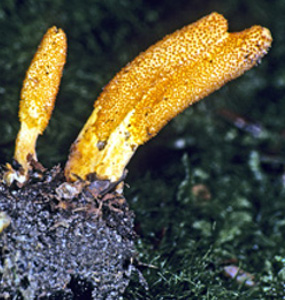Cordyceps militaris

Image Courtesy of Henry H. Mashburn
| Click to Enlarge |
| Click For Image Gallery |
|
Group of Fungi: Ascomycetes Family: Cordycipitaceae Latin Name: Cordyceps militaris (L.) Link Common Name: Orange Club Description: Cylindrical to club-shaped structure with a clearly distinct head and stalk, total height 3/4–2 in (2–5 cm), bright orange to orange-red or pale orange; head 3/8–3/4 in (1–2 cm) long and up to 1/4 in (0.5 cm) wide, surface roughened with numerous raised dots; stalk 1/4–1 1/4 in (0.5–3 cm) long, tapering slightly downward, reddish orange; spores hyaline in mass. Biological Role: This fungus is a parasite of the larvae or pupae of moths and butterflies. Habitat: On the ground among dead leaves or sometimes occurring on well-decayed wood. Geographical Distribution: Found throughout North America but most common east of the Rocky Mountains. Comments: The fruiting bodies of Cordyceps militaris may appear to be arising directly from the ground, but careful examination of the base of an individual fruiting body will reveal that it is attached to the larva or pupa of an insect, almost invariably that of a moth or butterfly. It is not uncommon for several fruiting bodies to arise from a single pupa. Because of its bright color, this fungus usually stands out against the layer of dead leaves on the forest floor. |
| Go Back |